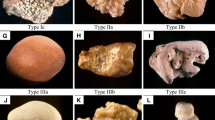Abstract
The aim of this paper is to study the variations in the percentage of the different types of renal stones with age and sex. Renal calculi were classified according to their composition and structure. Stone formers were divided according to age and sex, and the percentage of each kind of calculi in the different considered age periods for men and women were determined. It was found that calcium oxalate dihydrate calculi decreased with age, but only in men. These calculi were also clearly predominant in men. Hydroxyapatite calculi decreased with age in both men and women, but they were predominant in women. Uric acid calculi increased with age in both men and women, but were predominant in men. Finally, it was found that calcium oxalate monohydrate unattached calculi increased with age in both men and women. As a main novelty, the study here presented demonstrates the importance of distinguishing between calcium oxalate monohydrate papillary stones and calcium oxalate monohydrate unattached stones, since the etiologic factors responsible for their origin must be clearly different.




Similar content being viewed by others
References
Trinchieri A (1996) Epidemiology of urolithiasis. Arch Ital Urol Androl 68:203–249
Ramello A, Vitale C, Marangella M (2000) Epidemiology of nephrolithiasis. J Nephrol (13 suppl) 3:S45–S50
el-Reshaid K, Mughal H, Kapoor M (1997) Epidemiological profile, mineral metabolic pattern and crystallografic analysis of urolithiasis in Kuwait. Eur J Epidemiol 13:229–234
Gault MH, Chafe L (2000) Relationship of frequency, age, sex, stone weight and composition in 15,624 stones: comparison of results for 1980 to 1983 and 1995 to 1998. J Urol 164:302–307
Mandel N, Mandel I, Fryjoff K, Rejniak T, Mandel G (2003) Conversion of calcium oxalate to calcium phosphate with recurrent stone episodes. J Urol 169:2026–2029
Daudon M, Doré J-C, Jungers P, Lacour B (2004) Changes in stone composition according to age and gender of patients: a multivariate epidemiological approach. Urol Res 32:241–247
Grases F, García-Ferragut L, Costa-Bauzá A (1998) Analytical study of renal calculi. a new insight. Recent Res Devel Pure Appl Anal Chem 1:187–206
Grases F, Costa-Bauzá A, García-Ferragut L (1998) Biopathological crystallization: a general view about the mechanisms of renal stone formation. Adv Colloid Interface Sci 74:169–194
Grases F, Costa-Bauzá A, Ramis M, Montesinos V, Conte A (2002) Simple classification of renal calculi closely related to their micromorphology and etiology. Clin Chim Acta 322:29–36
Iwata H, Iio S, Nishio S, Takeuchi M (1992) Architecture of mixed calcium oxalate dihydrate and monohydrate stones. Scanning Microsc 6:231–238
Palatini P (2003) Microalbuminuria in hypertension. Curr Hypertens Rep 5:208–214
Asplin JR, Lingeman J, Kahnoski R, Mardis H, Parks JH, Coe FL (1998) Metabolic urinary correlates of calcium oxalate dihydrate in renal stones. J Urol 159:664–668
Curhan GC, Willet WC, Speizer FE, Stampfer MJ (2001) Twenty-four-hour urine chemistries and the risk of kidney stones among women and men. Kidney Int 59:2290–2298
Daudon M, Bader CA, Jungers P (1993) Urinary calculi: review of classification methods and correlations with etiology. Scaning Microsc 7:1081–1104
Daudon M, Labrunie M, Hennequin C, Lacour B, Jungers P (1997) Relative influence of calcium and oxalate urine concentration on the risk of calcium oxalate crystallization. In: Jungers P, Daudon M (eds) Renal stone disease. Crystallization process, pathophysiology, metabolic disorders and prevention. Elsevier, Paris, p 72
Daudon M, Reveillaud RJ (1984) Whewellite and weddellite, toward a different etiopathogenesis: the significance of morphological typing of calculi. Nephrologie 5:195–201
Pierratos AE, Khalaff H, Cheng PT, Psihramis K, Jewett MAS (1994) Clinical and biochemical differences in patients with pure calcium oxalate monohydrate and calcium oxalate dihydrate kidney stones. J Urol 151:571–574
Halloran BP, Lonergan ET, Portale AA (1996) Aging and renal responsiveness to parathyroid hormone in healthy men. J Clin Endocrinol Metab 81:2192–2197
Kotowicz MA, Melton LJIII, Cedel SL, O’Fallon WM, Riggs BL (1990) Effect of age on variables relating to calcium and phosphorus metabolism in women. J Bone Miner Res 5:345–352
Baylink DJ, Jennings JC, Mohan S (1998) Calcium and bone homeostasis and changes with aging. In: Hazzard W, Blass J, Ettinger W, Halter J, Ouslander J, (eds) Principles of geriatric medicine and gerontology, 4th edn. Mc Graw-Hill, pp 1041–56
Robertson WG (2001) The changing pattern of urolithiasis in the UK and its causes. In: Kok DJ, Romijn HC, Verhagen PCMS, Verkoelen CF (eds) Eurolithiasis. Shaker, Maastricht, p 9
Robertson WG, Peacock M, Heyburn PJ (1980) Clinical and metabolic aspects of urinary stone disease in Leeds. Scand J Urol Nephrol Suppl 53:199–206
Ford ES, Giles WH, Dietz WH (2002) Prevalence of the metabolic syndrome among US adults: findings from the third National Health and Nutrition Examination Survey. JAMA 287:356–359
Abate N, Chandalia M, Cabo-Chan AV Jr, Moe OW, Sakhaee K (2004) The metabolic syndrome and uric acid nephrolithiasis: novel features of renal manifestation of insulin resistance. Kidney Int 65:386–392
Acknowledgments
We gratefully acknowledge the financial support of Conselleria de Innovacio i Energia of Govern Balear (Grant PCTIB-2005GC4-06) and Dirección General de Investigación, Ministerio de Educació y Ciencia (Grant CTQ2006-05640).
Author information
Authors and Affiliations
Corresponding author
Rights and permissions
About this article
Cite this article
Costa-Bauzá, A., Ramis, M., Montesinos, V. et al. Type of renal calculi: variation with age and sex. World J Urol 25, 415–421 (2007). https://doi.org/10.1007/s00345-007-0177-4
Received:
Accepted:
Published:
Issue Date:
DOI: https://doi.org/10.1007/s00345-007-0177-4




